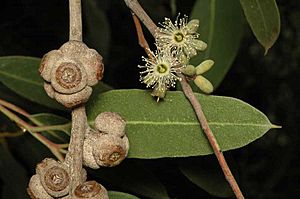Benson's stringybark facts for kids
Quick facts for kids Benson's stringybark |
|
|---|---|
 |
|
| Eucalyptus bensonii in the ANBG | |
| Scientific classification | |
| Genus: |
Eucalyptus
|
| Species: |
bensonii
|
Benson's stringybark is a special kind of eucalyptus tree. Its scientific name is Eucalyptus bensonii.
This tree is usually small, or it can grow as a mallee. A mallee is a type of plant that has many stems growing from the ground. It is found only in New South Wales, Australia. This means it is endemic there.
The tree has rough, grey or brown bark that looks like strings. This bark is on its main trunk and bigger branches. Its thinner branches have smooth bark. It has adult leaves that are shaped like a wide spear or an egg. Its flower buds grow in groups of seven, nine, or eleven. When the flowers bloom, they are white. After flowering, it grows fruit that looks like a cup or half a sphere, in small bunches.
What Benson's Stringybark Looks Like
Eucalyptus bensonii can be a mallee or a small tree. It usually grows up to about 8 metres (26 feet) tall. It has a special woody swelling at its base called a lignotuber. This helps the plant regrow after a fire.
The tree has rough, grey or brown bark. This stringy bark covers part or all of its main trunk and larger branches. Higher up, the bark is smooth and grey.
Young plants and new shoots have broad, egg-shaped leaves. These leaves are about 40 to 70 millimetres (1.6 to 2.8 inches) long. They are about 30 to 40 millimetres (1.2 to 1.6 inches) wide. Each leaf has a small stalk, called a petiole, about 5 to 7 millimetres (0.20 to 0.28 inches) long.
Adult leaves grow in an alternating pattern along the stem. They are shaped like a wide spear or are slightly curved. These leaves are about 60 to 120 millimetres (2.4 to 4.7 inches) long. They are about 19 to 37 millimetres (0.75 to 1.46 inches) wide. Their petioles are about 10 to 20 millimetres (0.39 to 0.79 inches) long. Both sides of the adult leaves are glossy green.
The flowers grow in groups of seven, nine, or sometimes eleven. They appear where the leaves meet the stem (called the axil). These flower groups are on a flat or angled stalk called a peduncle, which is about 4 to 12 millimetres (0.16 to 0.47 inches) long. Each individual flower does not have its own small stalk (a pedicel).
The mature flower buds are oblong, meaning they are longer than they are wide. They are about 5 to 10 millimetres (0.20 to 0.39 inches) long and 3 to 4 millimetres (0.12 to 0.16 inches) wide. The cap that covers the bud, called an operculum, is shaped like a cone or is rounded.
Benson's stringybark flowers from November to January. Its flowers are white. After the flowers, the tree produces woody fruit. These fruits are shaped like a half-sphere or a flattened sphere. They are about 5 to 7 millimetres (0.20 to 0.28 inches) long and 8 to 12 millimetres (0.31 to 0.47 inches) wide. They grow in clusters.
How it Got its Name
The scientific name Eucalyptus bensonii was first officially described in 1990. This was done by two botanists, Lawrie Johnson and Ken Hill. They found and described the tree near Mount Boonbourwa, which is close to Kandos.
Their description was published in a science journal called Telopea. The second part of the name, bensonii, is a special specific epithet. It was chosen to honor Douglas Howard Benson. He was an ecologist, a scientist who studies how living things interact with their environment, at the National Herbarium of New South Wales.
Where it Lives
Benson's stringybark is only found in a few separate places. It grows in the Wollemi National Park in New South Wales. This area is between the towns of Rylstone and Glen Davis. The tree prefers to grow in heathland areas on high plateaus.

